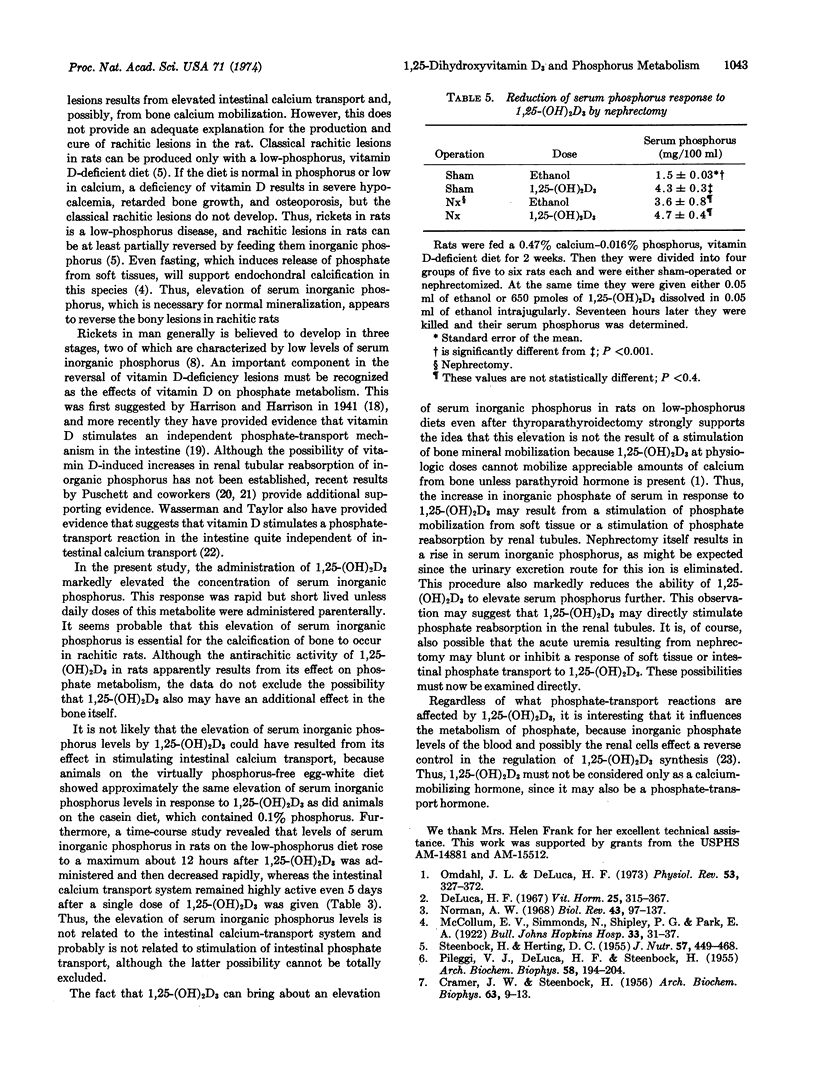Abstract
The intravenous injection of a single dose of 650 pmoles of 1,25-dihydroxyvitamin D3 to rats fed a vitamin D-deficient, low-phosphorus diet caused an elevation of serum phosphorus within 5 hours which reached a maximum in about 10-12 hours. This elevated serum phosphorus returned to deficiency levels 2-3 days later. On the other hand, a single injection of 650 pmoles of 25-hydroxyvitamin D3 produced a significant rise at 12 hours, reached a maximum in 24-36 hours, and was maintained for at least 7 days. The single dose of 1,25-dihydroxyvitamin D3 supported little calcification of bone, whereas the 25-hydroxyvitamin D3 produced marked calcification. Six-hundred and fifty pmoles of 24,25-dihydroxyvitamin D3 increased serum phosphorus only slightly and induced no calcification. When 1,25-dihydroxyvitamin D3 was given each day, a sustained increase in serum phosphorus and marked bone calcification resulted. In contrast to the serum phosphorus responses, intestinal calcium transport remained high 5 days after administration of a single dose of 1,25-dihydroxyvitamin D3. Serum calcium was not changed appreciably by any of the metabolites.
Thyroparathyroidectomized rats or rats fed a diet extremely deficient in phosphate still exhibited a marked elevation of serum phosphorus in response to 1,25-dihydroxyvitamin D3. The effect of 1,25-dihydroxyvitamin D3 on serum phosphorus was greatly reduced in nephrectomized rats, suggesting that the serum phosphorus response to 1,25-dihydroxyvitamin D3 may arise from an enhancement of phosphate reabsorption in the renal tubules.
It is suggested that 1,25-dihydroxyvitamin D3 cures rickets in rats by increasing the concentration of serum phosphorus rather than by increasing serum calcium concentration and calcium absorption.
Keywords: bone, calcification, transport, vitamin D
Full text
PDF




Selected References
These references are in PubMed. This may not be the complete list of references from this article.
- Boyle I. T., Miravet L., Gray R. W., Holick M. F., Deluca H. F. The response of intestinal calcium transport to 25-hydroxy and 1,25-dihydroxy vitamin D in nephrectomized rats. Endocrinology. 1972 Mar;90(3):605–608. doi: 10.1210/endo-90-3-605. [DOI] [PubMed] [Google Scholar]
- DeLuca H. F. Mechanism of action and metabolic fate of vitamin D. Vitam Horm. 1967;25:315–367. doi: 10.1016/s0083-6729(08)60039-4. [DOI] [PubMed] [Google Scholar]
- HARRISON H. E., HARRISON H. C. Intestinal transport of phosphate: action of vitamin D, calcium, and potassium. Am J Physiol. 1961 Dec;201:1007–1012. doi: 10.1152/ajplegacy.1961.201.6.1007. [DOI] [PubMed] [Google Scholar]
- Harrison H. E., Harrison H. C. THE RENAL EXCRETION OF INORGANIC PHOSPHATE IN RELATION TO THE ACTION OF VITAMIN D AND PARATHYROID HORMONE. J Clin Invest. 1941 Jan;20(1):47–55. doi: 10.1172/JCI101194. [DOI] [PMC free article] [PubMed] [Google Scholar]
- Holick M. F., Schnoes H. K., DeLuca H. F., Gray R. W., Boyle I. T., Suda T. Isolation and identification of 24,25-dihydroxycholecalciferol, a metabolite of vitamin D made in the kidney. Biochemistry. 1972 Nov 7;11(23):4251–4255. doi: 10.1021/bi00773a009. [DOI] [PubMed] [Google Scholar]
- Martin D. L., DeLuca H. F. Influence of sodium on calcium transport by the rat small intestine. Am J Physiol. 1969 Jun;216(6):1351–1359. doi: 10.1152/ajplegacy.1969.216.6.1351. [DOI] [PubMed] [Google Scholar]
- Norman A. W. The mode of action of vitamin D. Biol Rev Camb Philos Soc. 1968 Feb;43(1):97–137. doi: 10.1111/j.1469-185x.1968.tb01111.x. [DOI] [PubMed] [Google Scholar]
- Omdahl J. L., DeLuca H. F. Regulation of vitamin D metabolism and function. Physiol Rev. 1973 Apr;53(2):327–372. doi: 10.1152/physrev.1973.53.2.327. [DOI] [PubMed] [Google Scholar]
- PILEGGI V. J., DE LUCA H. F., STEENBOCK H. The role of vitamin D and intestinal phytase in the prevention of rickets in rats on cereal diets. Arch Biochem Biophys. 1955 Sep;58(1):194–204. doi: 10.1016/0003-9861(55)90106-5. [DOI] [PubMed] [Google Scholar]
- Puschett J. B., Moranz J., Kurnick W. S. Evidence for a direct action of cholecalciferol and 25-hydroxycholecalciferol on the renal transport of phosphate, sodium, and calcium. J Clin Invest. 1972 Feb;51(2):373–385. doi: 10.1172/JCI106823. [DOI] [PMC free article] [PubMed] [Google Scholar]
- STEENBOCK H., HERTING D. C. Vitamin D and growth. J Nutr. 1955 Dec 10;57(4):449–468. doi: 10.1093/jn/57.4.449. [DOI] [PubMed] [Google Scholar]
- Suda T., DeLuca H. F., Tanaka Y. Biological activity of 25-hydroxyergocalciferol in rats. J Nutr. 1970 Sep;100(9):1049–1052. doi: 10.1093/jn/100.9.1049. [DOI] [PubMed] [Google Scholar]
- Tanaka Y., Deluca H. F. The control of 25-hydroxyvitamin D metabolism by inorganic phosphorus. Arch Biochem Biophys. 1973 Feb;154(2):566–574. doi: 10.1016/0003-9861(73)90010-6. [DOI] [PubMed] [Google Scholar]
- Tanaka Y., Frank H., DeLuca H. F. Biological activity of 1,25-dihydroxyvitamin D3 in the rat. Endocrinology. 1973 Feb;92(2):417–422. doi: 10.1210/endo-92-2-417. [DOI] [PubMed] [Google Scholar]
- Tanaka Y., Frank H., DeLuca H. F. Role of 1,25-dihydroxycholecalciferol in calcification of bone and maintenance of serum calcium concentration in the rat. J Nutr. 1972 Dec;102(12):1569–1577. doi: 10.1093/jn/102.12.1569. [DOI] [PubMed] [Google Scholar]
- Wasserman R. H., Taylor A. N. Intestinal absorption of phosphate in the chick: effect of vitamin D and other parameters. J Nutr. 1973 Apr;103(4):586–599. doi: 10.1093/jn/103.4.586. [DOI] [PubMed] [Google Scholar]


